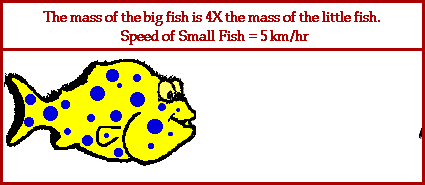
Little Fish in
Motion is Caught by Big Fish
Inelastic
Collision
A GIF Animation
The animation below portrays the
inelastic collision
between a very massive fish and a less massive fish. Before the
collision, the little fish is in motion with a velocity of 5 km/hr
and the big fish is at rest. The big fish has four times the mass of
the little fish. After the collision, both the big fish and the
little fish move together with the same velocity. (Collisions such as
this where the two objects stick together and move with the same
post-collision velocity are referred to as inelastic collisions.)
What is the after-collision velocity of the two fish?

Collisions between objects are governed by laws of momentum and
energy. When a collision occurs in an isolated system, the total
momentum of the system of objects is conserved. Provided that there
are no net external forces acting upon the two fish, the momentum of
the big and little fish before the collision equals the momentum of
the big and little fish after the collision.
The mathematics of this problem is simplified by the fact that
before the collision, there is only one object in motion and after
the collision both objects have the same velocity. That is to say, a
momentum analysis would show that all the momentum was
concentrated in the little fish before the collision. And
after the collision, all the momentum was the result of a single
object (the combination of the big and little fish) moving at an
easily predictable velocity.
The prediction of the final velocity of the two fish involves
determining the ratio by which the mass which is in motion changed;
and then dividing the initial velocity by that ratio. That is, if the
amount of mass in motion increases by a factor of two, then the
velocity would decrease by a factor of two (divide the original
velocity by two). If the amount of mass in motion increases by a
factor of five, then the velocity would decrease by a factor of five
(divid the original velocity by five). In the case of the animation
above, the amount of mass in motion increased by a factor of 5; a
change from say 1 kg for the little fish before the collision to 5 kg
for the combination of the big and litlle fish after the collision
(note that I can make up any numbers for mass as long as they meet
the criteria that the big fish has four times the mass as the little
fish). Since the amount of mass in motion increased by a factor of 5,
the velocity at which that mass is in motion must decrease by a
factor of 5. That is, the original velocity of 5 km/hr must be
divided by 5. Voila! The result is 1 km/hr; the big and little fish
move together with a velocity of 1 km/hr after the
collision.
For more information on physical descriptions of motion,
visit
The
Physics Classroom. Specific information is available there on the
following topics:
This page was created by
Tom
Henderson of
Glenbrook South
High School.
Comments and suggestions can be sent by e-mail to
Tom
Henderson.
A hearty thanks is due to lab assistant Amit Patel for his
assistance with the graphics and GIF animation.
This page last updated on 6/30/97.
